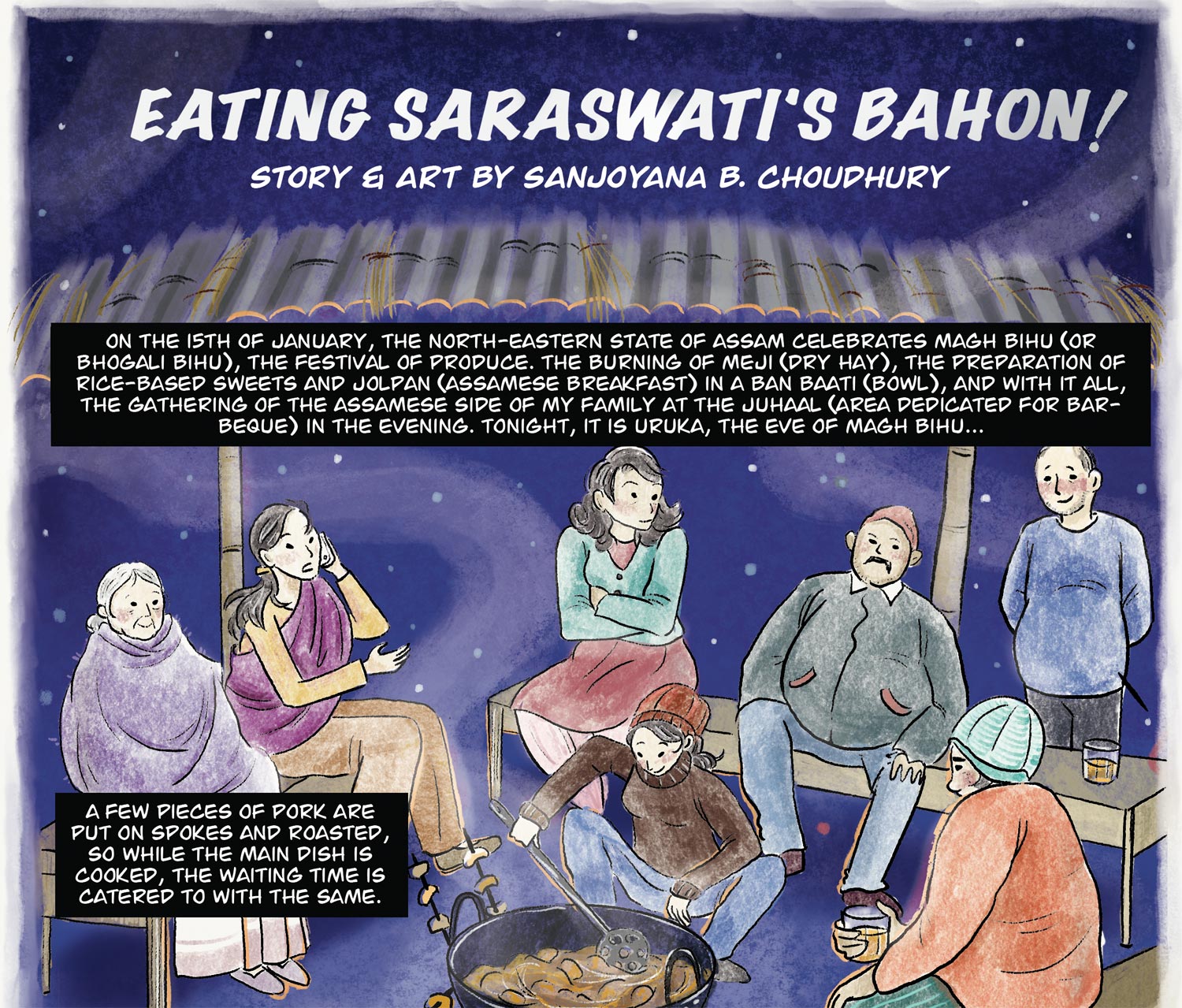
Vol 4 No 1 | Apr-Jun 2024
Eating Saraswati’s Bahon
Story and art by Sanjoyana B. Choudhury
Assamese cuisine
Assamese cuisine reflects the rich cultural heritage and diverse geography of Assam, a north-eastern state of India. Influenced by its lush valleys and hills, and the mighty Brahmaputra River, Assamese food is known for its simplicity, unique flavors, and use of indigenous ingredients.
Rice is a staple in Assamese cuisine, often accompanied by various lentils, fish, meats, and leafy greens. Fish, in particular, holds a prominent place in Assamese meals due to the abundance of rivers and ponds in the region. Dishes like masor tenga (sour fish curry) and maasor khar (fish cooked in alkaline water) are popular delicacies.
Herbs, bamboo shoots, and aromatic spices like ginger, garlic, and mustard seeds are commonly used to enhance the flavours of Assamese dishes. Traditional cooking techniques such as steaming, roasting, and fermenting are prevalent.
Over the centuries, Assamese cuisine has evolved through interactions with neighboring regions and communities, including tribes like the Bodos and the Mising. Today, it continues to preserve its authenticity while embracing modern influences, making it a cherished aspect of Assamese culture and identity.
https://assamtourism.gov.in/pages/cuisines-of-assam
https://www.northeastguide.in/blog/delicious-assamese-dishes-that-you-must-try
The vehicles of the gods
In Hinduism, it is believed that the gods and goddesses rode special vehicles called vahanas (bahon in Assamese). These vahanas could be animals or even non-living things that helped the gods and goddesses get around. For example, Indra, had a vahana named Airavata, a three-headed white elephant known to be strong, brave, and trustworthy. Or, as seen in this story, the vahana (bahon) of Saraswati was a swan.
In Myanmar, vahanas are referred to as vo, and they were used by kings, queens, and other important people. The word vahana means a carrier or vehicle, and it could be anything that helps you travel, like a horse or even a magical creature.
Overall, it is said there are around 55 animal vehicles of gods and goddesses of Hinduism, and they all have fascinating stories!
https://www.amarchitrakatha.com/mythologies/the-gods-and-their-vahanas/
https://blog.templesofindia.org/post/vahanas-the-rides-of-hindu-deities/
https://www.lonelyphilosopher.com/swan-goddess-saraswati/
The festival of Uruka
Uruka, celebrated in Assam, marks the eve of Magh Bihu, one of the state’s most important festivals. It’s a night of joyous festivities and camaraderie among communities. Uruka falls on the last day of the Assamese month of Pooh, usually in mid-January.
Preparations for Uruka begin days in advance, with families cleaning their homes, decorating them with traditional motifs, and gathering ingredients for the grand feast known as bhogali bhoj.
On Uruka night, people come together to build meji or bonfires, around which they engage in song, dance, and storytelling.
The highlight of Uruka is the lavish feast featuring an array of traditional Assamese dishes made from freshly harvested crops like rice and vegetables, as well as locally sourced meats and fish. It’s a time for unity and gratitude, as communities and families bond over shared meals, welcoming the harvest season.
https://assam.gov.in/about-us/399
https://www.outlooktraveller.com/experiences/heritage/all-you-need-to-know-about-magh-bihu-assams-harvest-festival

